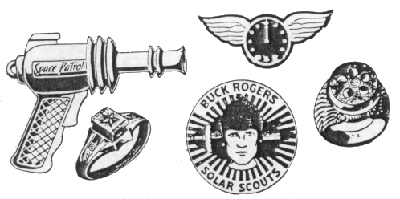|

This story was published in Radio Recall, the journal of the Metropolitan Washington Old-Time Radio Club, published six times per year.
Click here to return to the index of selected articles.
|
|
NEW BOOK ON RADIO PREMIUMS ARRIVES
Review by Stephen A. Kallis, Jr.
(From Radio Recall, October 2002)
As the Golden Age of Radio dwindles further into the past, memories dull, and often we "remember" things that aren't accurate. Good reference books are a "sanity check," and one of the latest is Collecting Toy Premiums, Bread, Cereal, Radio, by Prof. James L. Dundas (Atglen, PA, Schiffer Publishing Ltd 2001, 151 pp). Prof. Dundas actually covers more than just the above, including comic-book and television premiums as well.

The book has some interesting virtues. One is that there are short guides on ways to date the premiums, approximately, by patent number or by zip code for the mail-in or return address. Although this isn't entirely reliable (e.g., Ovaltine's patent on Shake-Up Mugs would apply to all subsequent models, not just the first Radio Orphan Annie version), it gives at least the earliest when an item could have appeared.
Not every premium associated with a particular radio program is shown in the book. For instance, while most of the radio and television premiums associated with the Captain Midnight programs are shown, quite a few aren't. Among the missing is the very rare Mystic Sun God Ring from 1946, the World War II MJC-10 Plane Spotter, and the Magic Blackout Lite Ups. Whereas the Tom Mix Ralston Straight Shooters issued roughly 250 premiums over its twenty-years-plus run, fewer than 20 items are displayed in the book. However, some 36 pages are devoted to the Straight Arrow program. Likewise, he displays the entire Nabisco Toytown card set, for 13 pages, including the Toytown Carnival.
Although the book is uneven, its ambitions are high, and the scope of its coverage includes some television premiums and cereal box inserts. The Captain Video Mysto-Coder is shown with sufficient clarity that someone with only a casual knowledge of cryptology could quickly learn to use one.
There is little text in the book, mostly picture captions identifying the premiums. For each category, there is introductory material, ranging from a few sentences to a short paragraph. Virtually all the captions are fairly short, basically providing the name and sometimes date of each photo, plus price guides. An interesting conflict in the Captain Midnight section is that he correctly identifies the cryptological radio premiums as Code-O-Graphs, but then describes the accompanying handbooks as "decoder manuals."
All the photographs of the premiums and other collectibles are both large enough to get some detail, and are in color. From the looks of some of the photos, these would seem to be from a private collection, possibly the author's.
Although this is not the definitive book on radio premiums (the closest to that specific ideal is "Ted Tumbusch's Tomart's Price Guide For Radio Premiums and Cereal Box Collectibles," regrettably out of print), it's a good addition to any collector's library. Its photographs are solid, and since all presented are in color, they are especially interesting for aspiring collectors who want to see what the premiums look like.
|